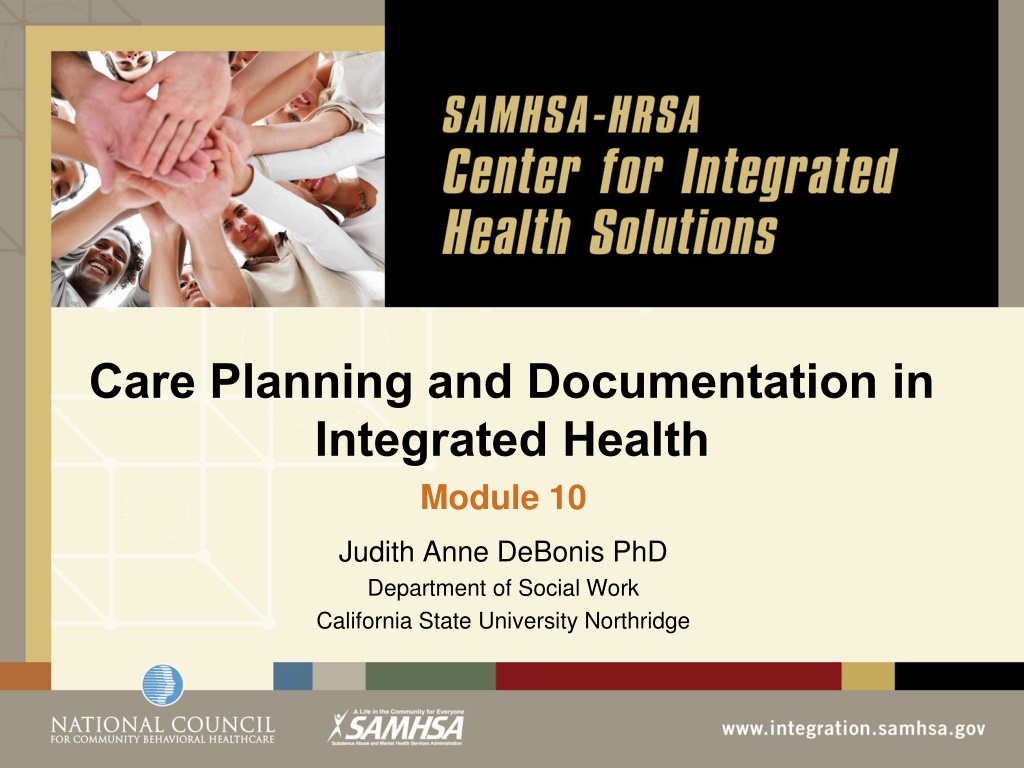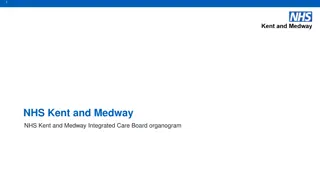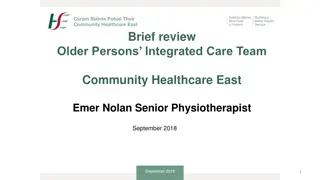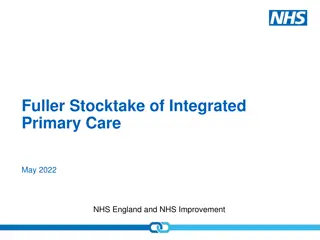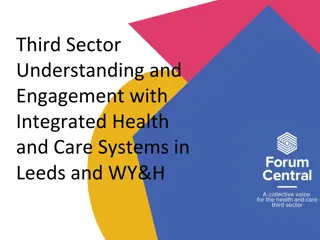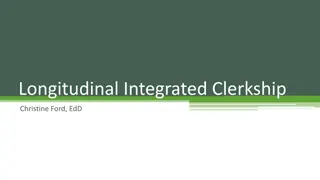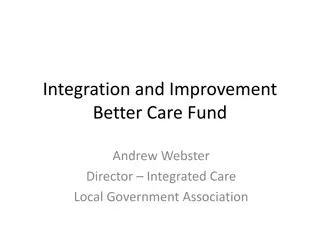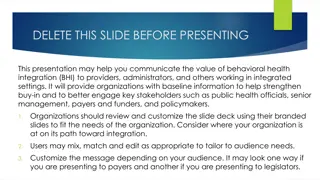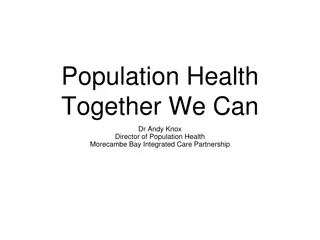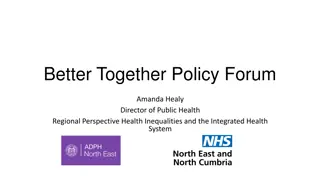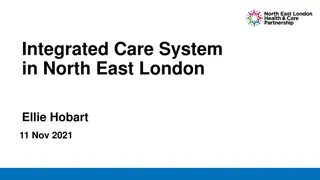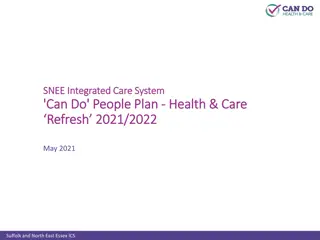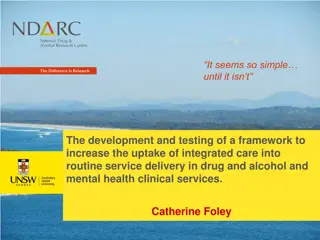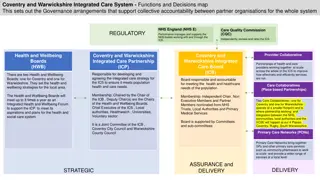Understanding Care Planning and Documentation in Integrated Health
Recognize the importance of the care planning process in Integrated Health, understand the differences between treatment plans, care plans, and action plans, and view care planning as a dynamic process involving ongoing updates and evaluation. Explore the traditional medical model versus newer patient-centered chronic care models, and learn how treatment planning has evolved from a bureaucratic exercise to a personalized, creative process. Discover the significance of treatment plans, care plans, and action plans in enhancing patient outcomes and promoting collaboration between healthcare providers and patients.
Download Presentation

Please find below an Image/Link to download the presentation.
The content on the website is provided AS IS for your information and personal use only. It may not be sold, licensed, or shared on other websites without obtaining consent from the author. Download presentation by click this link. If you encounter any issues during the download, it is possible that the publisher has removed the file from their server.
E N D
Presentation Transcript
Care Planning and Documentation in Integrated Health Module 10 Judith Anne DeBonis PhD Department of Social Work California State University Northridge
Module 10: Care Planning and Documentation in Integrated Health By the end of this module students will: Recognize the importance of the care planning process in IH Understand the differences between treatment plans, care plans, and action plans View the care planning process as an opportunity for creativity, discovery, and learning for both the patient and the provider Match and use empowering techniques in the implementation of a shared decision-making care planning process Acquire and utilize skills to enhance patient goals setting View care planning as a dynamic process involving ongoing updates and evaluation
Traditional Medical Model1 An individual s health plan and actions could be summed up as following the Doctor s orders
Newer Patient Centered Chronic Care Models 2 Today Patients are expected to be: 1. Informed The recipient of services must be the driving force in the development of a plan that articulates a vision of recovery 3 2. Proactive 3. Participate as a partner
Treatment Planning 3 Today, an alternative perspective Historically, a bureaucratic hurdle A time-consuming paper exercise performed to meet administrative or accreditation requirements. A learning experience between the patient and provider Accurate understanding of the individual needs, strengths, goals discovered through the alliance Disconnected, inconsequential with respect to what really happens in treatment Little to no impact on outcome. Not just filling in forms the new plans are informed, individualized, and built from creative thinking A roadmap that shapes and forms both the process and the product of treatment
Treatment Plans, Care Plans, Action Plans 4 Documents produced from the treatment planning process differ widely in definition and purpose 1. Treatment Plan Doctor s orders and recommendations with regard to the patient s medical care 2. Care Plan Based on the doctor s orders, the plan that the care manager and patient design in collaboration with the health team 3. Action Plan That portion of the care plan that the patient will implement at home. Contains individualized instructions that the patient has collaborated to develop. The care plan, created collaboratively by the health team, bridges the doctor s orders and the patient s personal goals Formal written plans can help to organize the work of teams and help patients to navigate the complexities of multidisciplinary care. 5
Individualizing the Care Plan 4 The Health Team The patient is considered the most important member of the health team Nurse Care Manager Specialists, Hospitals, other Healthcare Providers Care Plan Doctor/GP Patient
Both Patient & Provider Expertise Needed 6 Patients are the expert on their life Healthcare professionals are the expert on health practices What is important to me What I am willing to do What health actions I take For the patient, information may not be enough skills and confidence are also needed to participate fully.
Developing a Care Plan Using Shared Decision Making
Shared Decision Making (SDM) 7 Definition An interactive, collaborative process between providers and consumers that is used to make healthcare decisions in which at least 2 individuals work together as partners with mutual expertise to exchange information and clarify values in relation to options and thereby arrive at a discrete decision. GOAL Partnership A person-centered, supportive encounter which promotes the ideal conditions for effective decision making to occur Practitioner as a consultant to the consumer Helping to provide information Consumers are empowered with information so that their autonomy or control over healthcare decision making is increased To discuss options To clarify values and preferences To support consumer autonomy
How SDM Supports Patient Empowerment and Participation 7 In the shared decision-making process, practitioners are encouraged to think about and apply: 1. Self-directed care 2. Self-determination 3. Person-centered planning For consumers to participate fully as partners in a shared decision making process, they will need to information, skills, and confidence
Steps in a Shared Decision Making Process 7 1. Recognition that a decision needs to be made 2. Identification of the partners in the process as equals 3. Statement of options as equal 4. Exchange of information on pros and cons of options 5. Exploration of understanding and expectations 6. Identifying preferences 7. Negotiating options and concordance 8. Sharing the decision 9. Arranging follow-up to evaluate decision making outcomes
Matching Techniques and Approaches to the Shared Decision Making Process 1 Recognition that a decision needs to be made 7 Stage of Change 8 Empowerment 6 Solution-Focused 9 In contemplation: aware of the problem, but ambivalent about making a change How important do you think it is to others family, friends, doctor that you consider making these changes for your health? Identification of something YOU (the patient) want to accomplish or a problem that you want to resolve Decide what the person wants instead of what they don t want when what the person is doing is not working, have him or her do something different.
Matching Techniques and Approaches Identification of the partners in the process as equals 7 2 Stage of Change 8,11 Empowerment 6 Solution-Focused 9, 10 Providers respect the particular needs of persons in various stages and adjust their stance (nurturing parent, Socratic teacher, coach, consultant) to support specific actions necessary for the person to progress to the next stage Amplify and build on strengths to promote change in areas identified by the person and the view he/she holds for wanting things to be different Persons are allowed to direct their own course, focusing on one or two items that fit their interest or need This process will generate feelings of self efficacy, competence and build confidence Practitioners and patients construct the solutions together sometimes inventing them
Matching Techniques and Approaches Statement of options as equal 7 3 Stage of Change 8 Empowerment 6 Solution-Focused 9 Brainstorming offers multiple ideas for discovering new and creative possibilities. There are no right or wrong responses. All ideas are accepted and believed to hold potential. There are always solutions Each person will weigh a personalized set of pros and cons, choose from a variety of change processes, and choose among strategies for combating specific temptations There are more than one solution
Matching Techniques and Approaches Exchange of information on pros and cons of options 7 4 Stage of Change 8 Empowerment 6 Solution-Focused 9 Supporting the accumulation of personal reasons and benefits of change (pros) is necessary to shift the decisional balance from the costs of change (cons) Based on ideas generated from a brainstorm do any of the options seem workable for an individual s problems? Explore those options in detail. Exceptions for every problem exist and once discovered can be used to build a solution and a different view Helping the person to select the changes that will help them become more of what they like and want to see continue
Matching Techniques and Approaches Exploration of understanding and expectations 7 5 Stage of Change 8 Empowerment 6 Solution-Focused 9 In preparation, taking time to explore options and experiment can support individuals to choose a plan Setting goals that are small enough to be accomplished in one week is usually a reasonable expectation What will the change look like? How will things be different? Examining the details about how the change will feel, what will be noticed first when it occurs? Persons must have at least 70% confidence that they can accomplish the goal in 1 week an indication that the goal is reasonable and success is likely Understanding relapse is part of the process of change can encourage use of prevention tools
Matching Techniques and Approaches Identifying preferences 7 6 Stage of Change 8 Empowerment 6 Solution-Focused 9, 10 Deciding when to change, choosing the plan, the best tools and support for coping with setbacks, all is based on individual preferences Goals and actions taken to accomplish them are person-specific; there are many different paths and strategies that can be successful Instead what would you rather have? How will you be doing this? As you leave here today and you re on track, what will you be doing different or saying different to yourself?
Matching Techniques and Approaches Negotiating options and concordance 7 7 Stage of Change 8 Empowerment 1, 6 Solution-Focused 9,10 In all stages, change processes putting the focus on either thinking/feeling or behavior/doing are optional techniques to be applied to the process in agreement with the goals of the stage. Lower confidence levels can indicate that the goal should be renegotiated to a smaller step which has a greater change to be successful. Small changes lead to larger changes facilitates an easier way and simpler path to change What will make it worthwhile that you spent this hour here? Look for teachable moments where there is more openness to new information.
Matching Techniques and Approaches Sharing the decision 7 8 Stage of Change 8 Empowerment 1, 6 Solution-Focused 9 Solidifying the commitment to change often means sharing a plan with support network Tell people about your goals so they can provide support What would others say about the benefits of this change for you? The best feedback can come from others who also are managing a chronic condition How have you been able to decide this? At each stage decisions are made to take actions that can progress the person to the next stage. How will your change effect others?
Matching Techniques and Approaches Arranging follow-up to evaluate decision making outcomes 7 9 Stage of Change8, 11 Empowerment 6 Solution-Focused 9 In action consultant helps to monitor progress; offers a boost when progress is stalled and supports design of relapse prevention plan If something is not working, do something different. Review goal progress in 1 week; if successful, continue. Build on exceptions to the problems. Amplify small successes. Use brainstorming and problem-solving for discovering alternatives Miracle question response provides a detailed view of the change with specific indicators to watch for and reinforce. In maintenance preventing relapse, sustaining new behavior still requires commitment, energy.
Creating Client-Centered Goals that Reflect the Client s Desires
Lorig Three Empowering Techniques 6 Action Planning A way to turn a goal that you want to accomplish into a specific plan with steps Brainstorming A non-threatening way to generate a list of new ideas Problem Solving A process of self discovery and active engagement to explore options that lead to success
Action Planning 6 A Successful Action Plan turns goals into doable steps Is something YOU want to do Is reasonably accomplished in 1 week Is behavior-specific Answers: What? How much? When? How often? Begins with your confidence level at 7 or more (otherwise, renegotiate) Losing weight is not a behavior - not eating after dinner is
Value of Setting Goals 3 There is perhaps no greater expression of respect, understanding, hope, and empathy by the provider than the ability to elicit, acknowledge, and accept the individual and family goals 3 Patients who identify and bring personal goals to the attention of healthcare providers can: Receive support, encouragement, a sense of hope 1 Understand what specific results can be expected from treatments 2 Feel more motivated to participate in decision-making about their health 3
Solution-Focused Techniques For Well-Defined Goals: 10 Contributions 9 Helps identify strengths to be built upon Promotes expectation that small changes will lead to bigger changes Instills hope that change is possible Empowers changers Give a positive statement what the person will be doing or thinking rather than what they will not be doing or thinking Work with the person to describe specifically (in concrete terms)what the process will look like. Can you tell me more specifically how you will be doing that? What will you be doing when that happens? Use the person s words and language.
Solutions are a Type of Goal 9,10 Step 1 Define what the client wants rather than what he or she doesn t 3 Step 2 Look for what is working and do more of it 2 Step 3If what the client is doing is not working, have him or her do something different 1
SMART and Specific Using Smart Goals to Specify Objectives 3 S M A R T small pecific changes with a big impact easurable ttainable ealistic imely
Rewards as Part of Goal Setting Personalizing Rewards to Enhance Motivation 6 The real reward is a fuller and healthier life Self-reward frequently Add enjoyment to life it s part of the goal Give yourself some time off Do something 3 times a week for 10 minutes rather than every day Write down the goal tell others Note progress weekly Examples Deciding not to read the paper until after exercising Buying only 2 pieces of a favorite fruit at a time and walk the mile to the market each day for more Using money saved from not buying cigarettes to buy yourself something Remember that Olympic swimmers improved their race time when they rested in between their strenuous training and workouts!
Action Planning - Activity Making an Action Plan What are the typical goals set by consumers as part of their work with you? What do we do if a person has no goal? Using Lorig s ideas for successful Action Planning, how would you examine the goal and describe: How it fits the Lorig model How would it need to be adjusted Was the consumer successful? How does the Lorig model help when the person has no goal? The goal can be anything!
Brainstorming 6 Provide direction Step 1 What are some of the reasons people don t take medications as prescribed by their doctors? State the question to be brainstormed Step 2 Step 3 Write down every idea there are no right or wrong answers Step 4 Ask questions to clarify meaning Step 5 Use the ideas to summarize a point, begin a problem solving session, or create an action plan
Brainstorming - Activity Role Play Using Brainstorming Actions Generate a question Problem Someone you ve worked with is struggling with an obstacle to changing their behavior. Share ideas through brainstorming Dialogue to determine if any of the ideas might be used to help You and the person are at a loss as to how to proceed Make an action plan
Problem Solving 6 Step 1 Identify the problem or barrier Step 2 List ideas for solving the problem (from the brainstorm list) Step 3 Select one method to try In this process, identifying the problem or the barrier is the most difficult and most important! Step 4 Assess the results Step 5 Substitute another idea (if the first didn t work) Step 6 Use other resources Step 7 Accept that the problem may not be solvable now
Problem Solving - Activity Problem Solving Let s discuss How do you help them to put their goals into the SMART format? Think of some of the consumers you have spoken to What are some of the common goals they want to accomplish? How often do consumers set their goal as a series of small steps? Do you encourage setting up a reward plan? What would you imagine the person would answer: How will you know when it s time to make a change? What do you imagine will happen if you continue on as you are?
Integrating Other Providers in the Shared Planning and Decision-Making Process
Team Role in Treatment Planning3 A part of the commitment to person-centered care is attending to the process of developing, documenting and implementing an individual plan 3 The provider role is no longer all-knowing caregiver, but instead coach, architect, cheerleader, facilitator, and shepherd. 3 The plan is the glue that holds the team together and supports its success coordination is essential 1 2 The team is a group of people all working toward a common goal developing a plan that responds to the unique needs and desires of an individual and family 3 Both the team and the plan will need to be adaptable to change as the planning of care is a dynamic process
Engaging Families and Significant Others in the Care Planning Process
Involvement of Family and Friends 3 The family is a vital source of information and knowledge about the individual, their history, and needs, the role of culture in their lives, and other important details. Also, physical and emotional support of family can be a critical component of each individual's recovery 3 Serve as a reminder of history, which while painful, might communicate a message of hope about earlier goals 1 Respect for the individual and family/friends is essential; each is offered choice about the most comfortable way to participate and their preferences are accepted 2 May need to process past experiences and feelings, both good and bad, with regard to seeking treatment 3
Writing Effective and Concise Documentation
Documentation and Communication 12 Timely and concise information exchange enhances collaboration Communication between all providers is most effective and efficient when it is readily available, referred to and utilized with the consumer. Electronic Medical Records 13 Complex Considerations: 12 Record individual status and progress while also allowing for population dashboard data for decision support around key areas of interest: Allow multiple professionals to enter and access information Can be used to track behaviors, goals, progress and as timed reminders to ensure guideline care Offer educational and resources related materials for staff /consumers For metrics and measurements to be used effectively, information and data need to be collected, stored, easily accessed and presentable to those who will access them. Record policies, development of electronic health records and communication about data all need to be addressed Computer competence is an essential skill for social workers in IH
Whats your note preference? PIE, DAP, or SOAP? 4 Formats to help with writing a clear and concise progress note Problem identification, Intervention, Evaluation PIE Description, Assessment, Plan DAP SOAP Subjective, Objective, Assessment, Plan All structured and all require assessment as part of the note Well written notes in Integrated Health are SHORT and TO THE POINT! Can problem-oriented notes be used effectively to support an objective-oriented and recovery-oriented record?
Benefits of Well Written Notes Including a mini assessment is beneficial in that it keeps all providers clear and focused on the individual needs and desires of the consumer 3 A Win-Win 3 Medical records tell the story of a person and any reader should come away with an better understanding With good documentation it is more difficult to provide ineffective services for an extended period of time. The lack of progress becomes obvious to everyone and the provider and team will re-evaluate If service is effective, that too will be obvious and the enthusiasm will generate support and additional forward motion
Ongoing monitoring, reviewing and re-evaluation of goals 3 Assessment and reassessment allows for information gathering which can help to evaluate and monitor progress, modify and update the plan as needed Periodic review of the treatment plan: 1. Keeps the plan accurate and up-to-date 2. Helps maximize benefit from treatment interventions by determining what is working and what needs adjustment May uncover other barriers to treatment success that have not been identified Review may: Highlight areas of strength that can be used to increase positive outcomes in other less successful aspects of treatment Offer an opportunity to brainstorm about areas that are problematic and make choices for next steps
Considering Medical Necessity Standards and Requirements
Administrative Requirements 3 What services and where services are provided and at what level of care 5 Components of Medical Necessity: 3 1. Indicated where there is a diagnosis 2. Appropriate match between service and need 3. Efficacious likelihood that interventions or services will be effective Discussion Point: How can medical necessity requirements protect and help consumers and families? 4. Effective determining the impact and value of services provided 5. Efficient when services are appropriate, efficacious, and effective In what ways might these requirements be inappropriately applied and cause denial of services?
Documenting Medical Necessity Insurance will deny coverage if necessity is not well documented While guidelines for documentation vary across states, agencies and provider types, and will differ according to standards related to specific needs most include: Don t Forget: 1. A clear concise statement of the presenting problem, the history of the present illness, the diagnosis, and current assessment and status Include signatures, dates, and professional credentials Be brief but descriptive 2. A rationale for why services are necessary (what risks will likely occur if not treated) Individualize and tailor wording to the specific needs of the patient is key 3. A description indicating how the services offered will be sufficient in amount, duration, and type to achieve the purpose or goals Use progress notes to update any changes to initial service recommendations
References 1. Lorig, K. (2001). Patient education: A practical approach. Thousand Oaks, CA: Sage Publications, Inc. 2. Wagner, EH. (1998) Chronic disease management: What will it take to improve care for chronic illness? Effective Clinical Practice. 1: 2-4. 3. Adams, N. & Grieder, D. (2005). Treatment planning for person-centered care. Amsterdam: Elsevier Academic Press. 4. Aquilino, A., DeBonis, J. A., Mola, E., Musilli, A., Panfilo, M., Rollo.R. (2009, October). Project Leonardo: Final report of a study to evaluate the feasibility and effectiveness of a model of disease and care management in the primary healthcare system for the management of patients chronic conditions. Il Sole 24 Ore, Special Health (Sanita`) Supplement, Pp. 3-66. 5. Wagner, EH. (2000). The role of patient care teams in chronic disease management. BMJ, 320 (February), 569-572. with
References 6. Lorig K. Living a healthy life with chronic conditions: self-management of heart disease, arthritis, diabetes, asthma, bronchitis, emphysema & others. 3rd ed. Boulder, CO: Bull, 2006. 7. Shared Decision-Making in Mental Health Care: Practice, Research, and Future Directions. HHS Publication No. SMA-09-4371. U.S. Department of Health and Human Services. Substance Abuse and Mental Health Services Administration. 8. Prochaska, J .O., Norcross, J. C., DiClemente, C. C. (1994). Changing for good: A revolutionary six-stage program for overcoming bad habits and moving your life positively forward. New York: Avon Books. 9. DeJong, P., & Berg, I. K. (2007). Interviewing for solutions. Pacific Grove, CA: Brooks/Cole Publishing Company. 10.Walter, J. L., & Peller, J. E. (1992). Becoming solution-focused in brief therapy. New York: Brunner Routledge.
